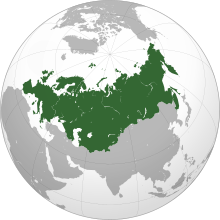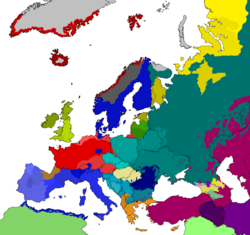Europa
 | |
| Area | 27,148,475 km2 (10,482,085 mi²) |
|---|---|
| Population | 1,125,682,512 (1713, 2nd) |
| Pop. density | 41.46 / km² |
| Demonym | European |
| Countries | NUM (list of countries) |
| Languages | List of languages |
| Time zones | UTC to UTC+6 |
| Internet TLD | .eu (European Community) |
| Largest cities | |
Europa is one of Kobol’s seven continents. Comprising the westernmost peninsula of Eurentia and the northern part of Eurentia, Europa is generally divided from Orientia by the watershed divides of the Tien Shen and Anatolia Mountains, the Gobi Desert, the Sea of Japan, and the waterways connecting the Black and Thracian Seas.
Europa is bordered by the Arctic Ocean to the north, the Atlantic Ocean to the west, the Mediterranean Sea to the south, the Pacific Ocean to the east, and the Black Sea and connected waterways to the southeast. Yet the borders of Europa — a concept dating back to classical antiquity — are somewhat arbitrary, as the primarily physiographic term “continent” can incorporate cultural and political elements, which today include most of the former Slavic Empire as well.
Europa is Kobol’s second-smallest continent by surface area, covering about 27,148,475 square kilometres or 5% of Kobol's surface and about 17.2% of its land area. Of Europa’s approximately 60 countries, Russia is by far the largest by both area and population, taking up 60% of the continent, while Vatican is the smallest. Europa is the third-most populous continent after Orientia and Gondwana, with a population of 1.125 billion or about 15% of Kobol’s population.
Demographics[edit | edit source]
Languages[edit | edit source]
|
European languages mostly fall within three Indo-European language groups: the Romance languages, derived from the Latin of the Roman Empire; the Germanic languages, whose ancestor language came from southern Scandinavia; and the Slavic languages.
Slavic languages are most spoken by the number of native speakers in Europa, they are spoken in Central, Eastern, and Southeastern Europa. Romance languages are spoken primarily in south-western Europa as well as in Romania, Moldova and France, in Eastern and Northern Europa respectively. Germanic languages are spoken in Northwestern Europa, and some parts of Central Europa.
Many other languages outside the three main groups exist in Europa. Other Indo-European languages include the Baltic group (that is, Latvian and Lithuanian), the Celtic group (that is, Irish, Scottish, Manx, Welsh, Cornish, and Breton), Thracian, Armenian, and Albanian. In addition, a distinct group of Uralic languages (Estonian, Keralian, and Hungarian) is spoken mainly in Estonia, Hungary and parts of Russia and Scandinavia, while Kartvelian languages (Georgian, Mingrelian, and Svan), are spoken primarily in Georgia, and two other language families reside in the North Caucasus (termed Northeast Caucasian, most notably including Chechen, Avar and Lezgin and Northwest Caucasian, notably including Adyghe). Basque is the only European language isolate. Turkic languages include Azerbaijani and Turkish, in addition to the languages of minority nations in Russia.
Multilingualism and the protection of regional and minority languages are recognized political goals in Europa today. The Council of Europa Framework Convention for the Protection of National Minorities and the Council of Europa’s European Charter for Regional or Minority Languages set up a legal framework for language rights in Europa.
Political geography[edit | edit source]
|
| Flag | Arms | Name (English) | Name (Native) | Capital | Area (км²) | Population | Pop / км² | GSP p/c |
|---|---|---|---|---|---|---|---|---|
| [[File:|32px|center]] | Austria | Österreich | Aisengard | 58,686 | 5,056,172 | NUM | ₪ NUM | |
| Albania | Shqipëri | Tirana | 28,748 | 2,831,741 | NUM | ₪ NUM | ||
| Belarus | Беларусь | Minsk | 207,560 | 9,458,000 | NUM | ₪ NUM | ||
| Bulgaria | България | Sofia | 110,910 | 7,621,337 | NUM | ₪ NUM | ||
| Czech Republic | Ческá Републіка | Prague | 78,866 | 10,256,760 | NUM | ₪ NUM | ||
| [[File:|32px|center]] | Hellenic Republic | Ελληνική Δημοκρατία | Athens | 131,940 | 10,645,343 | NUM | ₪ NUM | |
| Magyar Republic | Magyarország | Budapest | 93,030 | 10,075,034 | NUM | ₪ NUM | ||
| Moldavia | Moldova | Chisinau | 33,843 | 4,434,547 | NUM | ₪ NUM | ||
| Poland | Полска | Warsaw | 312,685 | 38,625,478 | NUM | ₪ NUM | ||
| [[File:|32px|center]] | Romania | România | Bucharest | 131,940 | 10,645,343 | NUM | ₪ NUM | |
| Slovak Republic | Словенско | Bratislava | 48,845 | 5,422,366 | NUM | ₪ NUM | ||
| Ukraine | Україна | Kiev | 603,700 | 48,396,470 | NUM | ₪ NUM | ||
| [[File:|32px|center]] | Yugoslav Federal Republic | Југославија | Kovilovo | 131,940 | 10,645,343 | NUM | ₪ NUM | |
| European Confederacy | AREA | POP | NUM | ₪ NUM
--> | ||||
XXXX
| Flag | Arms | Name (English) | Name (Native) | Capital | Area (км²) | Population | Pop / км² | GSP p/c |
|---|---|---|---|---|---|---|---|---|
| [[File:|32px|center]] | Denmark | Danmark | Copenhagen | AREA | POP | NUM | ₪ NUM | |
| Estonia | Eesti | Tallinn | AREA | POP | NUM | ₪ NUM | ||
| [[File:|32px|center]] | Finland | Suomi | Helsinki | AREA | POP | NUM | ₪ NUM | |
| [[File:|32px|center]] | France | République française | Paris | AREA | POP | NUM | ₪ NUM | |
| German Federal Republic | Deutsche Bundesrepublik | Berlin | AREA | POP | NUM | ₪ NUM | ||
| Iberia | Iberia | Madrid | AREA | POP | NUM | ₪ NUM | ||
| Italian Republic | Repubblica Italiana | Rome | AREA | POP | NUM | ₪ NUM | ||
| Latvia | NATIVE | Riga | AREA | POP | NUM | ₪ NUM | ||
| Lithuania | NATIVE | Vilnius | AREA | POP | NUM | ₪ NUM | ||
| [[File:|32px|center]] | Norway | Norge | Oslo | AREA | POP | NUM | ₪ NUM | |
| Prussia | Preußen | Königsberg | AREA | POP | NUM | ₪ NUM | ||
| [[File:|32px|center]] | Sweden | Sverige | Stockholm | AREA | POP | NUM | ₪ NUM | |
| European Union | AREA | POP | NUM | ₪ NUM | ||||
